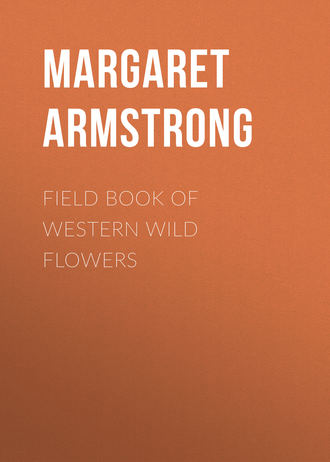 полная версия
полная версияField Book of Western Wild Flowers
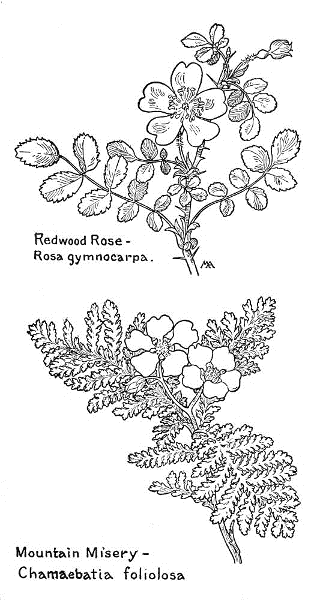
Redwood Rose – Rosa gymnocarpa.
Mountain Misery – Chamaebatia foliolosa.
This is the only kind of Stellariopsis; perennial herbs; the leaves with many, minute, crowded, overlapping leaflets; the flowers white, in open clusters; bractlets, sepals, and petals five; stamens fifteen; pistil one, surrounded by bristles.
Pussy-tails
Stellariópsis santolinoìdes
(Ivesia)
White
Summer
California
The leaves of this odd little plant look like catkins, or the sleek, gray tails of some little animal. They are cylindrical in form, three or four inches long, composed of many minute leaflets, crowded closely around a long, central stem. These little leaflets, hardly more than green scales, are smothered with soft, white down, which gives the whole "tail" a silky, silvery-gray appearance. From the midst of a bunch of these curious leaves, which are mostly from the root, spring several very slender stems, widely branching above, from six to twelve inches tall, and at the ends of the branches are airy clusters of pretty little flowers, like tiny strawberry-blossoms. These little plants grow in sandy soil, at high altitudes, and are plentiful on the gravelly "domes" around Yosemite.
There are a good many kinds of Horkelia; perennial herbs, with compound leaves, usually with many leaflets, and flowers in clusters; calyx cup-shaped, or saucer-shaped, with five teeth and five bractlets; stamens ten; pistils two or many, with long slender styles, and borne on a receptacle like that of Potentilla, which these plants resemble, though the flowers are usually smaller, in closer clusters.
Horkèlia fúsca
White
Summer
Cal., Oreg., Nev.
A rather attractive plant, for the foliage is pretty, though the flowers are not very conspicuous. The rather stout, roughish stem, often purplish, is from one to two feet tall and the leaves are rather dark green, slightly sticky and sometimes downy. The flowers are about half an inch across, with white petals, tinged with pink, and are well set off by the dark reddish or purplish calyxes and buds, but the petals are too far apart, and there are not enough flowers out at one time, for the effect to be good. This varies a good deal in hairiness and there are several varieties. It is common in Yosemite.
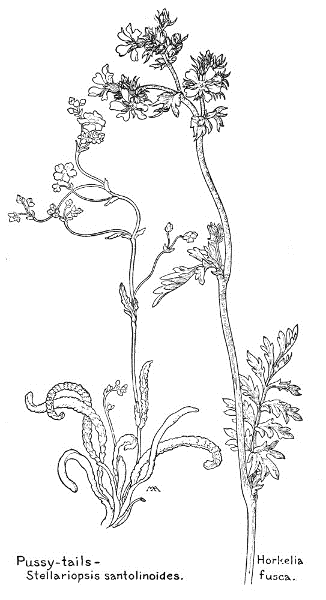
Pussy-tails – Stellariopsis santolinoides.
Horkelia fusca.
There are several kinds of Cowania.
Cliff Rose
Cowània Stansburiàna
Yellow
Spring, summer
Southwest
Altitude and soil make a great difference in the beauty of this shrub. On the rocky rim of the Grand Canyon it is from four to eight feet high, picturesquely gnarled and twisted, but stunted looking, the gray bark hanging off the crooked branches and thick, distorted trunk in untidy shreds, the flowers pale, scanty, and but faintly scented. Halfway down Bright Angel trail it is a glorious thing, full of color and fragrance, about twelve feet high, luxuriant and healthy-looking. The small, leathery, evergreen leaves, crowded in bunches along the branches, are glossy and rich in color, setting off the light yellow flowers, with golden centers, which form long wands of bloom. The upper branches are clustered closely their whole length with blossoms, and when the wind sways the flowering branches to and fro they exhale an exquisite fragrance like orange flowers. The bloom is at its best in the Canyon in May, but there are still some lingering flowers in August. The calyx is top-shaped, with the petals and the two rows of numerous stamens on the throat of the tube. The pistils, from five to twelve, are densely woolly. The akenes have pale, silky-hairy tails, two inches or more in length, suggesting gone-to-seed Clematis. For some occult reason this shrub is called Quinine Bush at the Grand Canyon.
There are two kinds of Aruncus, resembling Spiraea; with small white flowers, the stamens and pistils in separate flowers on different plants. Aruncus is a word used by Pliny to designate a goat's beard.
Goat's Beard
Arúncus sylvéster
(Spiraea aruncus)
White
Summer
Northwest, etc.
A pretty plant, from three to seven feet high, with somewhat branching stems and smooth leaves, thin in texture. The minute, cream-white flowers are crowded closely along the many sprays which make up the very loose cluster, which is about a foot long, the effect of the whole being exceedingly airy and graceful and in fine contrast to the handsome foliage. This grows in mountain woods, across the continent and in Europe and Asia.

Cliff Rose – Cowania Stansburiana.
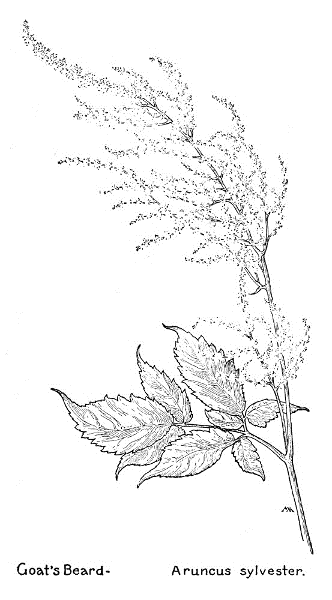
Goat's Beard – Aruncus sylvester.
There are only a few kinds of Adenostoma, evergreen shrubs, with small, narrow, resinous leaves and clusters of small, white flowers.
Chamise, Greasewood
Adenóstoma fasciculàtum
White
Spring
California
This is a very attractive shrub, from two to ten feet high, with long, slender branches, clothed with close bunches of leaves and bearing large clusters of tiny flowers, something like Spiraea. They have a feathery, creamy appearance, owing to the pale yellow stamens, and the olive-green foliage sets them off to perfection, the effect of the whole being very graceful, as the slender, flower-tipped branches sway to and fro in the wind. This is the most abundant and characteristic shrub of the higher Coast Ranges and Sierra Nevada Mountains and sometimes covers miles of mountain slopes, looking a good deal like heather when it is not in bloom. When the chaparral is composed entirely of this shrub it is called chamisal. A. sparsifòlium of southern California, has scattered leaves and larger flowers. It is very fragrant and used medicinally by Spanish Californians and Indians, who call it Yerba del Pasmo, or "convulsion herb."
There are many kinds of Spiraea, natives of the north temperate zone; shrubs, without stipules and with clusters of white or pink flowers.
Flat-top Meadowsweet
Spiraèa corymbòsa
White
Spring, summer
Northwest, etc.
This is an attractive plant, from one to three feet tall, with slender, reddish-brown stems, with but few branches, and smooth, bright green leaves, paler on the under side. The small flowers are cream-white, with pinkish buds, and form very pretty, feathery, flat-topped clusters, about three inches across. This is found on banks and rocky places, in the mountains, and grows also in the East.
Pyramid Bush
Spiraèa pyramidàta
(S. betulaefolia in part)
Pink, whiteSpring, summer
Northwest
An attractive plant, but not so pretty as the last. It is about the same height, but more branching, with dark bluish-green leaves, somewhat pale on the under side. The flowers are white or pale pink, with deep pink buds, and form long clusters, not so feathery as the last, because the stamens are not so long. This grows in the mountains.
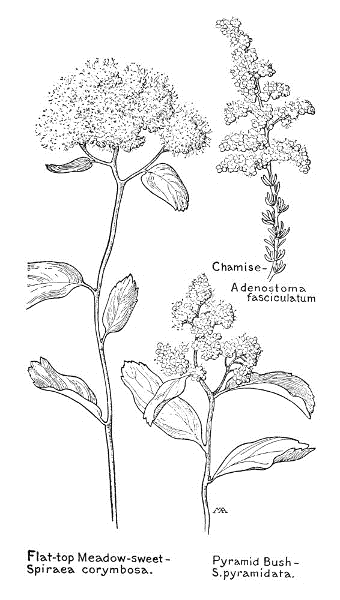
Chamise – Adenostoma fasciculatum.
Flat-top Meadow-sweet – Spiraea corymbosa.
Pyramid Bush – S. pyramidata.
Hardhack, Steeple-bush
Spiraèa Doúglasii
Pink
Spring, summer
Wash., Oreg., Cal.
A handsome shrub, from three to five feet high, with rather coarse leaves, smooth, but with a dull surface, and pale with close down on the under side, and bearing many beautiful, compact spires of small, pink flowers, warm in tone and deeper in color towards the center, with numerous, long, pink stamens, which give a very feathery appearance. The flowers are slightly sweet-smelling and bloom first at the top of the cluster, so that the effect of the whole spire, which is six or eight inches long, is light pink and fuzzy at the top, deepening below to the raspberry-pink of the buds. This grows along the edges of meadows and near brooks.
There are two kinds of Chamaebatiaria, both western; low shrubs; the flowers with five sepals, five petals, and about sixty stamens; the pistils five, more or less united.
Fern-bush
Chamaebatiària millefòlium
(Spiraea)
White
SummerArizona
A pretty and unusual-looking shrub, about three feet high, with reddish stems and shreddy bark, the downy leaves, pale yellowish-green in color, arranged at intervals along the branches in soft feathery bunches. The flowers are like small strawberry blossoms, slightly fragrant, and form pretty clusters. This grows on rocks, along the rim of the Grand Canyon, clinging to the edge and overhanging the depths.
There is only one kind of Coleogyne.
Coleógyne ramosíssima
Yellow
Spring
Southwest
The plateau in the Grand Canyon is covered for miles with this low shrub, which gives the landscape its characteristic pale desert coloring. The flowers, over half an inch across, with one or two pairs of three-lobed bracts at base, grow singly at the tips of the twigs and, unlike most of this family, have no petals and only four, spreading sepals, bright yellow inside, two of them pointed and the alternate two more round in shape. The ovary is enclosed in a yellow, hollow, urn-shaped receptacle, surrounded by numerous stamens inserted on its base, the yellow anthers with threadlike filaments. The very small, narrow, toothless leaves are evergreen, leathery and stiff, opposite, grayish in color and imperceptibly downy, clustered in small separate bunches along the rigid twigs, which are set almost at right angles to the reddish-gray branches and rather swollen at the joints. The whole shrub is from two feet to four feet high, stiff, almost thorny, and rather forbidding in appearance, but the odd little flowers are pretty.

Coleogyne – ramosissima.
Hardhack – Spiraea Douglasii.
Fern-bush – Chamaebatiaria millefolium.
There are several kinds of Argentina, differing from Potentilla in the leaflets and the style.
Silver-weed
Argentìna Anserìna
(Potentilla)
YellowSpring, summer, autumn
North America, etc.
This forms large straggling clumps of many, pale, downy stems, lying on the ground and rooting at the joints, like strawberry runners, with handsome foliage and pretty flowers. The leaves are rich green on the upper side and covered with silky white down on the under, giving a silvery appearance, and the flowers are an inch or more across, bright yellow, with centers of the same shade, and have long flower-stalks, sometimes as much as a foot tall. This is common and conspicuous in wet meadows and also grows in Europe and Asia.
There are only a few kinds of Dryas, shrubby plants, living in cold and arctic regions. The Latin name means "wood-nymph."
Alpine Avens
Drýas octopétala
White
Summer
Northwest, etc.
This is a charming little plant, from two to five inches tall, forming low, matted clumps of many branching stems, lying on the ground and woody at the base, and many stiffish leaves, with prominent veins, dark green and smooth on the upper side and white with close down on the under, their dark tones setting off the pure-white flowers, which have downy flower-stalks and are about an inch across, with about eight petals, a golden center and the calyx covered with sticky hairs. The seed-vessels are large and feathery. This grows in alpine places, across the continent, reaching an altitude of fourteen thousand feet, and in Europe and Asia.
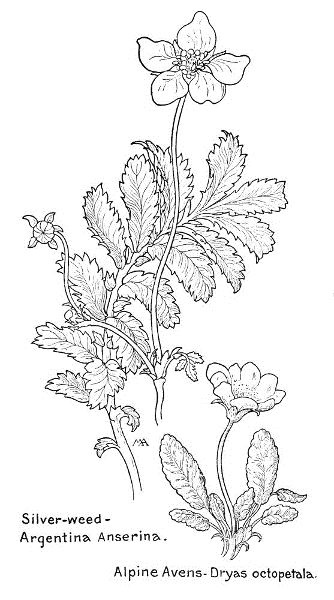
Silver-weed – Argentina Anserina.
Alpine Avens – Dryas octopetala.
There are many kinds of Cinquefoils, mostly natives of the north temperate zone, usually herbs, with compound leaves and yellow, white or purple flowers, always with pedicels; the flat or cup-shaped calyx, with five, main teeth, alternating with five, tooth-like bractlets; petals five, broad, often notched; stamens numerous, with threadlike filaments and small anthers, near the base of the calyx-cup; pistils numerous, on the conical, hairy receptacle, which does not become fleshy or juicy, each pistil maturing into a dry, seed-like akene. Potentilla means "powerful," as some sorts are medicinal. They often resemble Buttercups, but never have shiny petals, and Buttercups do not have bractlets between the calyx-lobes.
Arctic Cinquefoil
Potentílla emarginàta
Yellow
Summer
Northwest
A dear little plant, forming low tufts, two or three inches high, with thin, brownish stipules, bright green leaves, more or less hairy, and bright yellow flowers, deeper in color towards the center and about half an inch across. This grows in high northern mountains across the continent and in Siberia.
Silky Cinquefoil
Potentílla pectinisécta
Yellow
Spring, summer
Utah, Ariz., Wyo.
The foliage of this plant is a lovely shade of silvery gray, which suits the yellow flowers. It has several stoutish, reddish, stems, a foot to a foot and a half tall, springing from clumps of leaves, with long leaf-stalks and five to seven leaflets. The bright-yellow flowers are each three-quarters of an inch across and the whole plant is conspicuously covered with long, thick, white, silky down, particularly on the under side of the leaves.
Shrubby Cinquefoil
Dasíphora fruticòsa
(Potentilla)
Yellow
Spring, summer
West, etc.
This is the only kind of Dasiphora, a pretty shrub, very branching and leafy, one to four feet high, dotted all over with charming flowers. The bark is shreddy and the gray-green leaves are covered with silky down, with rolled back margins, and paler on the under side. The flowers, single or in clusters, are over an inch across, with clear yellow petals and deeper yellow anthers. This is common in the mountains, across the continent, up to an altitude of ten thousand feet, and is a troublesome weed in northern New England. It is also found in Europe and Asia.
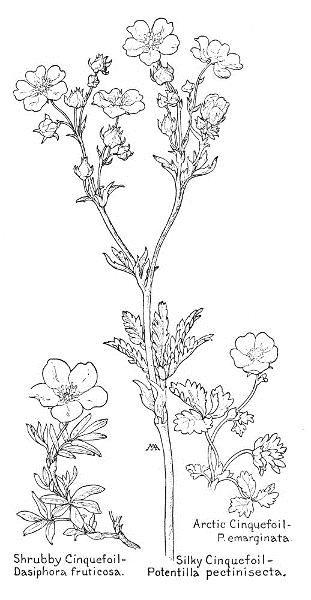
Arctic Cinquefoil – P. emarginata.
Shrubby Cinquefoil – Dasiphora fruticosa.
Silky Cinquefoil – Potentilla pectinisecta.
There are several kinds of Sericotheca, much like Spiraea, except the fruits.
Ocean Spray
Sericothèca discolor (Spiraea) (Holodiscus)
White
Summer
Northwest and Southwest
A handsome conspicuous shrub, from three to eight feet high, without stipules, with roughish, dull-green leaves, toothed or lobed, but not with leaflets, and pale and woolly on the under side. The tiny flowers form beautiful, plumy, branching clusters, eight inches or more in length and almost as much across, cream-white and fuzzy, drooping and turning brownish as the flowers fade. This is common in the mountains.
There are numerous kinds of Rubus, in temperate regions, with white, pink, or purple flowers, and red, black, or yellowish "berries." The fruit is not really a berry, but a collection of many, tiny, round stone-fruits, crowded on a pulpy, conical receptacle. That of the Raspberry has a "bloom," and falls off the receptacle when ripe, but the Blackberry has shining, black fruit, which clings to the receptacle. Rubus, meaning "red," is the ancient Latin name for the bramble. Raspberries were cultivated by the Romans in the fourth century.
Salmon-berry
Rùbus spectàbilis
RedSummer
Northwest
A handsome bush, not at all trailing, from three to nine feet high, with dark-brown, prickly stems, fine foliage and flowers, and conspicuously beautiful fruit. The leaves are nearly smooth, with three leaflets, and the flowers, about two inches across, are a brilliant shade of deep pink, not purplish in tone, with yellow centers, and grow singly, or two or three together. The fruit is a firm, smooth raspberry, over an inch long, bright orange-color, more or less tinted with red, with a rather pleasant but insipid taste and not very sweet. This grows in woods. It is rather confusing that this should be called Salmon-berry in the West, for in the East that is the common name of Rubus parviflorus.
Common Blackberry
Rùbus vitifòlius
White
Spring, summer
California, etc.
An evergreen bush, a few feet high and more or less erect; or the prickly stems trailing on the ground, or climbing over other shrubs, and sometimes eighteen feet long. The leaves are downy, or almost smooth, usually rather coarse in texture, and all but a few of the upper ones have from three to seven leaflets. The flowers are about an inch across and the petals vary a good deal, being sometimes broad and sometimes rather long and narrow. This is common from southern California to British Columbia.
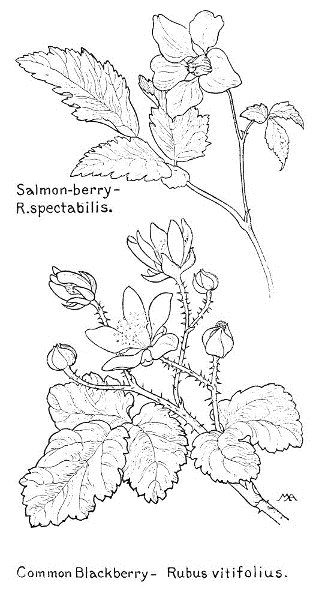
Salmon-berry – R. spectabilis.
Common Blackberry – Rubus vitifolius.
Thimble-berry
Rùbus parviflòrus
White
Spring, summer
West, etc.
In shady mountain woods we find this attractive plant, which is called Salmon-berry farther east. It also resembles the eastern Thimble-berry, but its flowers are prettier, for they are white instead of purplish-pink. It has several branching stems, from two to six feet high, the lower ones woody, with shreddy bark and the upper stems pale green, slightly rough and hairy, but with no thorns. The large maple-like leaves are thin in texture, but almost velvety, with hairs on the veins of the under side and on the leaf-stalks, and are bright green, with three or four, toothed lobes. The flowers are occasionally pinkish and measure about two inches across, and grow, a few together, at the ends of long flower-stalks. The petals are slightly crumpled and there are usually five of them, but both sepals and petals vary a good deal in number; the green sepals are velvety, pale inside and tipped with tails, and the pale yellow center is composed of a roundish disk, covered with pistils and surrounded by a fringe of numerous yellow stamens. The fruit is a flattish, red raspberry, disappointing to the taste, for it is mostly seeds. This is found as far east as Michigan.
Creeping Raspberry
Rùbus pedàtus
White
Summer
Northwest
A charming little vine, without prickles, the stems from one to three feet long and rooting at the joints, trailing over rocks and moss and creeping along the ground, ornamented with pretty leaves, with from three to five leaflets, and sprinkled with white flowers, half an inch or more across, and often also with juicy, red raspberries. This grows in rich soil, in mountain woods.
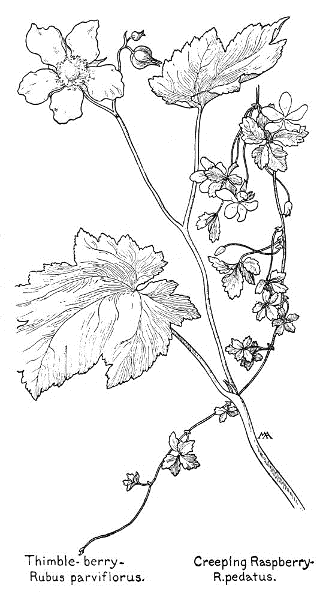
Thimble-berry – Rubus parviflorus.
Creeping Raspberry – R. pedatus.
There are a good many kinds of Strawberry, natives of the north temperate zone and the Andes. They are perennials, with running stems, rooting at the joints; the flowers white, or rarely pink, with slender, often drooping pedicels, forming loose clusters; the flower-stalks springing from tufts of root-leaves, which have three, toothed leaflets and a pair of sheathing stipules at the base of the long leaf-stalk; the sepals five, alternating with sepal-like bractlets; the petals five, with short claws and not notched; the stamens numerous, with slender filaments; the receptacle roundish or cone-shaped, becoming enlarged, red and juicy, in fruit, bearing minute, dry akenes, scattered over its surface, or set in pits. Fragum is the Latin name for strawberry, meaning "fragrant."
Wood Strawberry
Fragària bracteàta
White
Spring, summer
West
A slender little plant, growing in light shade, in rich soil, along streams, in rocky woods and producing runners very freely. The stipules are papery and reddish, the thin, dull-green leaves are slightly silky on the upper side, when young, and the leaflets are sharply and coarsely toothed, somewhat wedge-shaped, broad at the tips, the two side ones uneven at base. There is usually a little bract, halfway up, on both the flower-stalk and the leaf-stalk. The flowers are nearly an inch across, with fuzzy, bright yellow centers, and the fruit is light red, with a good flavor, somewhat cone-shaped, the akenes scattered over its smooth, shining, even surface and but slightly attached to it.
Sand Strawberry
Fragària Chiloénsis
White
Spring, summer
Wash., Oreg., Cal.
A charming plant, a few inches tall, with thick, glossy, dark green leaves, paler and hairy on the under side, and pure-white flowers, with bright yellow centers. They are about an inch across and are well set off by the masses of dark foliage. This has large, delicious berries and grows abundantly on beaches and sand dunes near the sea, from San Francisco to Alaska. It is often cultivated.
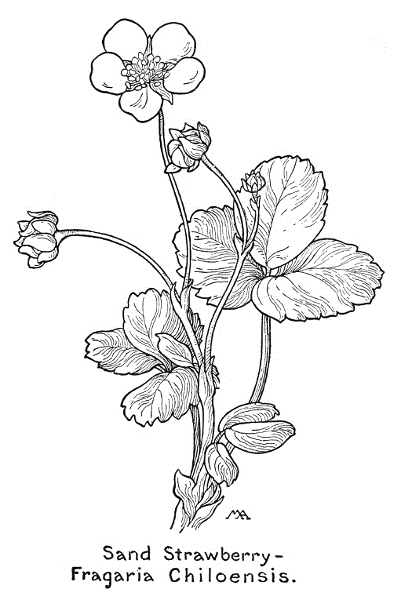
Sand Strawberry – Fragaria Chiloensis.
PEA FAMILY. Fabaceae
A very large family, including many important plants, such as Clover, Alfalfa, Peas, and Beans; herbs, shrubs, vines, and trees, distinguished principally by the flower and fruit, resembling the butterfly-like corolla and simple pod of the common Pea; leaves alternate, usually compound, with leaflets and stipules; calyx five-toothed or five-cleft; petals five. The upper petal, or "standard," large, covering the others in the bud, the two at the sides standing out like "wings," the two lower ones united by their edges to form a "keel," enclosing the stamens, usually ten, and the single pistil with a curved style; the ovary superior.
There are numerous kinds of Anisolotus, widely distributed, common, difficult to distinguish; mostly herbs, some slightly shrubby; leaves with two or many, toothless leaflets; calyx-teeth nearly equal; petals with claws, free from the stamens, wings adhering to the keel, incurved, blunt or beaked; stamens joined by their filaments, in two sets of one and nine, anthers all alike; style incurved; pods two-valved, often compressed between the seeds, never inflated. These plants have several common names, such as Bird-foot, Trefoil, Cat's-clover, etc., and are called Crowtoes by Milton.

